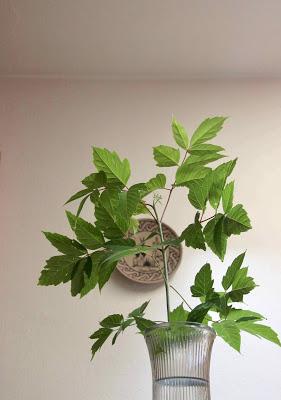
The boxelder I’m following this year, the one that grows in a nook formed by warehouse walls, has changed only subtly since last month’s report. It has more leaves—not that I’ve counted them or measured their cover, but I can see new ones emerging, even though the first signs of summer’s end have appeared. Must be an optimistic tree.

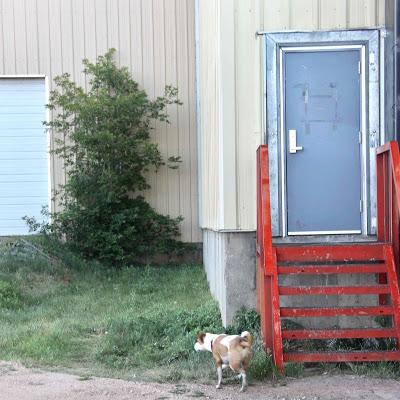
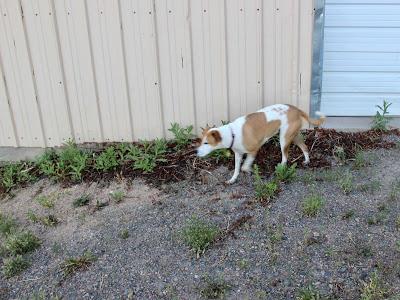
The sand dock along the warehouse wall is done storing energy underground, and is now a brown tangle of dead leaves (Canada thistle sticking up through).
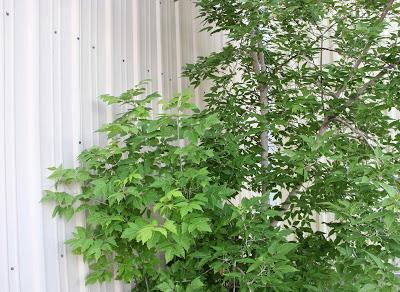
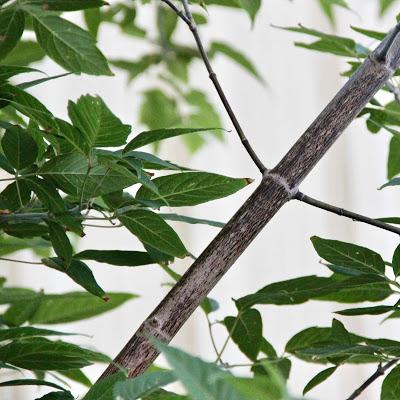
Boxelder’s oppositeness—stems as well as leaves.
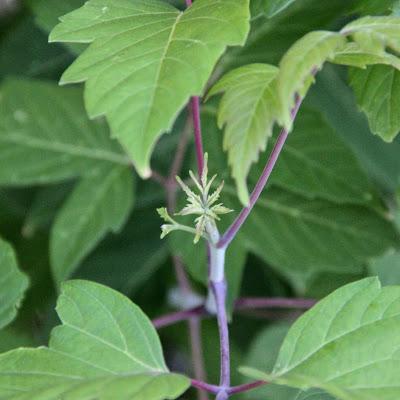
Fresh new leaves … in September!
The miniature leaves emerging at the tips of the branchlets had interesting forms, surprising actually. But in the morning shade it was impossible to capture them in focus, so I took a branchlet home.
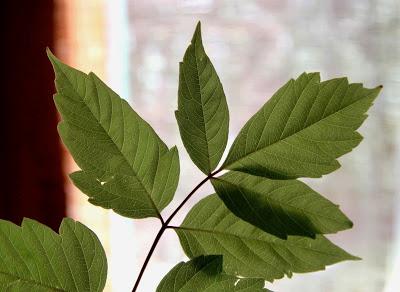
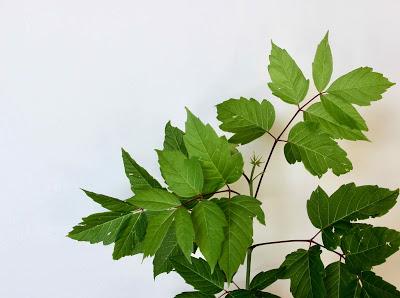
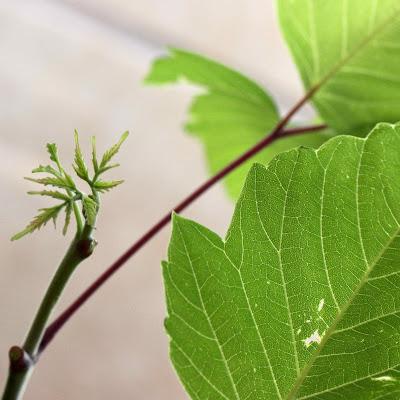 Interesting! These two young leaves look deeply incised and pinnately-lobed (keep this in mind for the trick question coming up soon).
Interesting! These two young leaves look deeply incised and pinnately-lobed (keep this in mind for the trick question coming up soon).
Q: "How many leaves in the next photo?"
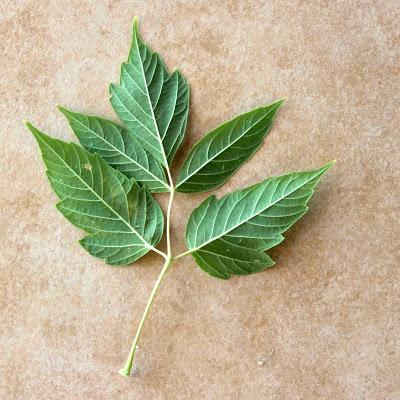 A: "Just one." This is a little trick we ranger naturalists would use on nature walks. Most people would answer five. Then we explained how actually this is a single leaf, i.e., from one bud, and that it split into leaflets as it grew. At least one former ranger I know took it a step further, overlapping the leaflets to show that the boxelder is indeed a maple, a member of the genus Acer.
A: "Just one." This is a little trick we ranger naturalists would use on nature walks. Most people would answer five. Then we explained how actually this is a single leaf, i.e., from one bud, and that it split into leaflets as it grew. At least one former ranger I know took it a step further, overlapping the leaflets to show that the boxelder is indeed a maple, a member of the genus Acer.Even so, doesn’t it seem a bit odd that boxelder ended up in the genus Acer—that a tree with compound leaves was thrown into a group of simple-leaved brethren(1), especially given the proclivity of taxonomists for splitting? If you agree that this is odd, you’re not alone. In fact, you’re in the company of some of the most esteemed pioneering North American botanists.

Courtesy Pearson Scott Foresman.
The boxelder is native to North America, but by the mid 1700s, it had become common in Europe as well:“ … it is in great request for adorning pleasure grounds, on account of the rapidity of its growth, and the beauty of its foliage, whose bright green forms an agreeable contrast with the surrounding trees.” (Michaux & Hillhorn 1819)So it's not surprising that Carl Linneaus included the boxelder in the first edition of his Species Plantarum (1753), in which he formally introduced our binomial system of nomenclature. He assigned the scientific name in use today: Acer negundo (the complete name has “L.” appended to it because Linneaus is the authority). Why did he place boxelder in the genus Acer? Probably because it has the same distinctive fruit as maples: two-winged two-seeded samaras that spin in the wind (aka wingnut, helicopter, whirlybird, whirligig and spinning jenny).
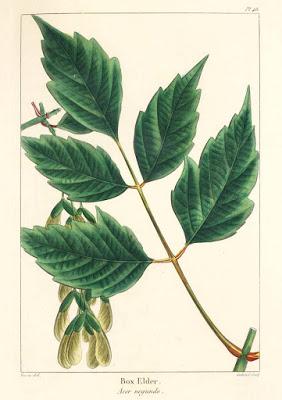
Acer negundo L. (Michaux & Hillhouse 1819); samaras (keys) lower left.
When Andre Michaux published the first North American sylva in 1810 (2), boxelder was Acer negundo, following Linneaus’s lead. And so it remained for some thirty years, during which time Thomas Nuttall published periodic updates, adding new species that he and others discovered.But by the time of Nuttall’s 1849 edition, boxelder had moved up in status (see p 90). It was in its own genus, Negundo, the boxelders, which included two species and a rumored third. The common boxelder became Negundo aceroides. N. californicum was the California boxelder, discovered by David Douglas, a Scottish botanist and major contributor to the North American flora. “It is remarkable for the almost tomentose pubescence of its leaves” (densely fine hairy), most of which had just three leaflets. Even the samaras were pubescent. Nuttall also mentioned a possible third species, christened N. mexicanum by Swiss botanist Augustin Pyramus de Candolle (3), but declined to recognize it until more material was available for study.
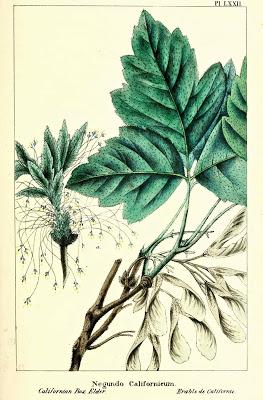
California boxelder, Negundo californicum (Nuttall et al. 1865).
I had hoped to find out why the boxelders were segregated into their own genus. But I wasn't able to solve that mystery. The Plant List considers Negundo aceroides an unresolved name, attributable to either John Torrey or Conrad Moench. Some sources hold Nuttall accountable as well. In any case, Torrey and Asa Gray, two of our great botanical luminaries, included it and N. californicum in their North American flora, published 1838-1840 (pp 49-50).But Negundo turned out to be a passing fancy. At some point, boxelders were lumped back in with the maples. However, the California and Mexican boxelders were not abandoned—they’re now varieties. In fact, seven varieties of Acer negundo are recognized; the distributions of all but var. mexicanum are shown here (source):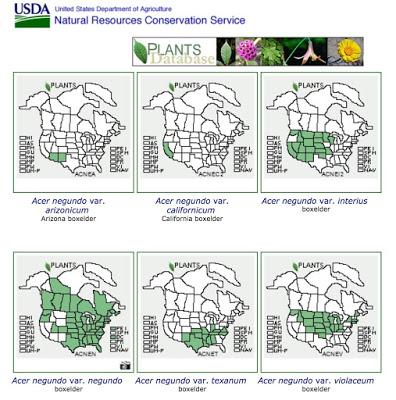 My boxelder is Acer negundo var. violaceum, because its branchlets are glabrous (no hair) with a glaucous bloom—hence the bluish-green stem in the photo below.
My boxelder is Acer negundo var. violaceum, because its branchlets are glabrous (no hair) with a glaucous bloom—hence the bluish-green stem in the photo below.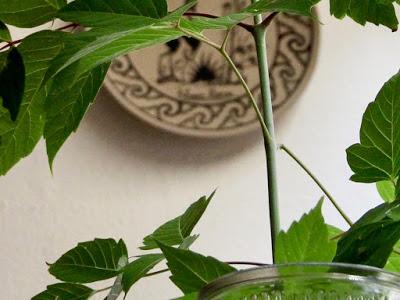 Notes
Notes(1) Boxelder is not the only odd maple. The great majority have simple lobed leaves, but there are several with either compound or simple unlobed leaves (details here).(2) A sylva is all the trees growing in a specific region; also “silva”.(3) Negundo mexicanum may have been based on material collected by botanist Jean-Louis Berlandier, a student of DeCandolle, who joined a Mexican scientific expedition in the late 1820s at the recommendation of his mentor (source).Sources
Biodiversity Heritage Library Flickr Album for The North American sylva v.2 (1865).
Constantino, G. 2018 (March 29). Exploring the First American Silva. Biodiversity Heritage Library Blog.Michaux, FA, and Hillhouse, AL. 1819. The North American sylva, or A description of the forest trees of the United States, Canada and Nova Scotia; considered particularly with respect to their use in the Arts , and their introduction into Commerce [English translation]. Paris, printed by C. D’Hautel. Available online at Biodiversity Heritage Library.Nuttall, T, Michaux, FA, and Smith, JJ. 1865. The North American sylva; or, A description of the forest trees of the United States, Canada and Nova Scotia. Considered particularly with respect to their use in the arts and their introduction into commerce, v. 2. Philadelphia, Rice, Rutter & co. Available online at Biodiversity Heritage Library.
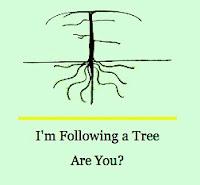 For more news about trees from various parts of the world, visit the monthly tree-follower gathering kindly hosted by The Squirrelbasket. New members always welcome!
For more news about trees from various parts of the world, visit the monthly tree-follower gathering kindly hosted by The Squirrelbasket. New members always welcome!